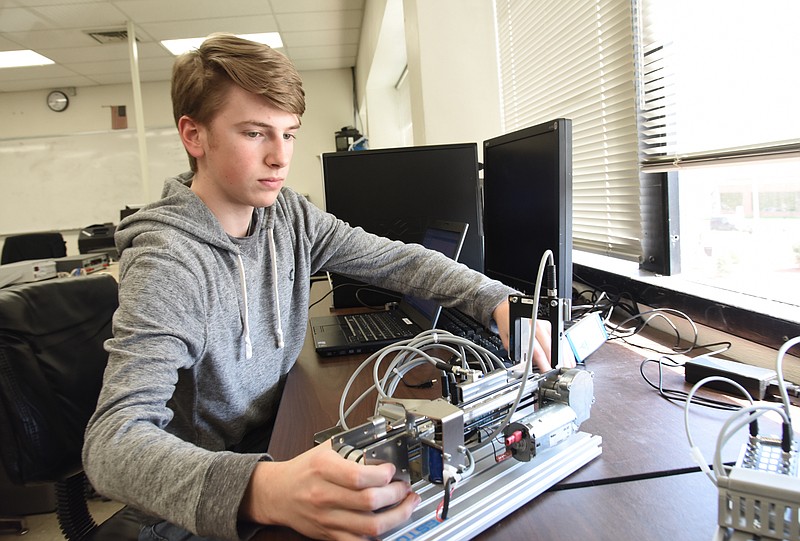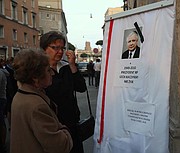While some industries continue to struggle after the economy took a hit in 2008, others are flourishing.
Local employees working in graphic communications, health science and mechatronics say jobs are plentiful not only in town but nationally, and offer diverse career options for interested students.
Nichols Career Center, established as part of Jefferson City Public Schools in 1976, offers a dozen programs in fields relevant to local industry needs.
Junior and senior high school students participating in Nichols programs spend half of each day in their program classes for the whole year. If they complete the full two years of the program, theyre eligible to take a test and earn the industry-recognized certificate, which allows them to launch into an entry-level position right out of high school.
Each program has an advisory council made up of business partners, students, former students, parents and professionals working in post-secondary to fine-tune the programs and make sure they stay up to industry standards. If a program falls behind what the industry calls for or has become obsolete, then it could get cut from Nichols, said Nichols Director Sharon Longan.
Graphic communications and mechatronics are two industries that have evolved and expanded with the non-stop growth of technology. Health sciences has grown with the aging population of the Baby Boomer generation. Employers say there are numerous medical careers, and there are always openings.
Health sciences
Jade Forck, a JCHS senior, said she was feeling iffy about going into the medical field, but was talked into taking the health sciences course at Nichols by other students who really enjoyed it.
As a people person, Forck said she quickly grew to love the classes, which cemented her decision to further her education in medicine " potentially as a registered nurse.
I just really enjoy it, and I like being able to help people, she said of her time working at St. Joseph Bluff as a Nichols student. I like seeing them smile.
The capstone health sciences for seniors incorporates a lot of field work at Heisinger Bluffs and St. Josephs Bluffs retirement homes in Jefferson City. Students work with patients doing basic tasks such as taking temperatures and blood pressure and measuring fluids, said teacher Shellie Goodin.
Students have to communicate with staff all the time, Goodin said. We have a strict call-in policy. Literally they have a patient waiting for them. They have to be dependable and accountable. Theyre human beings; people can get hurt.
In the yearlong course, students are exposed to a lot of medical terminology and strengthen their communication skills. Eligible students can take a test to receive an industry-recognized certificate and can work at a retired living center or hospital right out of high school.
The course gives employers a chance to observe students who may become future employees, said St. Joseph Administrator Stormy Anderson.
Having the students here is one of the highlights, Anderson said. It reminds staff to be on their toes. It also gives us a great opportunity to observe students. When theres an opening, we have an idea who the best candidate is.
Long-term care is really about relationships and honoring the whole person, she said. We think you come here to live and living here the way you want to live.
Anderson said she cant stress enough how desperately the industry needs people to go into health care. Its an employees market right now.
Health care support positions are expected to grow 23 percent by 2024, adding 974,000 new positions from 2014-24, according to the Bureau of Labor Statistics. The median annual salary was $26,440.
Health care practitioners and technical occupations are expected to grow 16.4 percent, adding 1.3 million positions, according to the Bureau of Labor Statistics. The median annual wage in 2014 was $61,710.
Graphic communications
When Cheryl Wolf started teaching graphic communication in 1990, the class had one computer and students processed film in a dark room.
Now everything is done electronically.
Students who take the class get a base knowledge of the industry software, including Adobe InDesign, Photoshop and Illustrator. Throughout the year, they learn the start-to-finish process of designing, formatting and printing anything from large banners to vinyl posters to coffee mugs.
The district recently purchased " mostly with grant money " a $15,000 large format printer and Xerox with Fiery work stations for $35,000 to keep up with industry standards.
All the projects are in-house, so they arent competing with any business partners.
One neat thing is students get a feel for all the fields, if they want to be a designer or more hands-on, Wolf said.
While students can go straight into the workforce doing screen printing, if students want design jobs its better if they further their education.
Over 10 years, the job growth in this field is expected to climb 4.1 percent and add more than 100,000 jobs by 2024, according to U.S. Bureau of Labor Statistics data for the arts, design, entertainment and media occupations. In 2014, the median annual salary was $45,180. The bureau did not have projection statistics for other graphic communication careers.
Brian Mutert, a 1996 Jefferson City High School graduate, is now an account executive and production team lead for Brown Printing in Jefferson City.
Graphic communications is in his blood, he said. His dad worked in the printing business all of Muterts life, and his family started its own printing business in 2000.
One of the main allures is the variety of work, Mutert said.
Whenever you look at graphic communications, theres so many different entities that need some form of graphic communications, Mutert said. Instead of having a copywriter, you have a graphic communications person. Thats where weve seen the biggest job growth. You have people who want to make sure the message stays consistent on multiple platforms.
Taking graphic communications at Nichols gave Mutert a good base of knowledge to build on so he could further his education. He earned a bachelors degree at the University of Central Missouri, which Wolf and Mutert said is one of the best colleges in Missouri for graphic communications.
Wolf recently received a letter from a UCM graphic technology professor who wrote, We still have the same problem " more paid internships and jobs available than students and graduates to fill them.
Mutert said theres an abundance of job opportunities not only in Missouri, but nationwide.
He now sits on the advisory board to help ensure Nichols students receive a top-notch education that matches what employers need.
The best thing abut Nichols is it offers several opportunities, he said. If students have no desire to go to technical college, they can serve a company. If they do get that base knowledge, they can expand it. I think thats one of the values of the program. They can home in on what track they want to take next.
Mechatronics
Mechatronics teacher Matt Yeager said nearly everything people use involves some sort of technology.
A student raised his hand, held up a wooden pencil and asked, What about this?
That pencil wasnt whittled by hand, Yeager said.
Technology has expanded to everything in our lives. He said the term electronics is outdated because people think of electronics as radios and televisions. Now, electronics are phones, cars and houses.
Someone had to design the ATM software at the bank, maintain and fix it.
Mechatronics is the umbrella term for control systems, computers, mechanical systems and electronic systems. The course teaches students a wide range of skills so theyre prepared to do a variety of work after graduation.
In the yearlong program, Yeager said, he has about seven curricula he runs through. Its a broad field, and the goal is to be able to work on anything that involves computer software interacting with the world around it, Yeager said.
The program was revamped and renamed after the district brought in a 3-D printer, AutoCAD, control systems and more computer software.
Students who take mechatronics for the full two years are eligible to earn the certification, but Yeager recommends students attend post-secondary school to broaden their job horizons.
Clark Philbert, a 2014 graduate of New Bloomfield and former Nichols student, plans to graduate from the State Technical College of Missouri this spring and already has a job offer. Taking the classes at Nichols gave him a foundation for what hes learned at the technical college.
I believe it wasnt as much the program as Matt Yeager, Philbert said. Hes enthusiastic about learning and enthusiastic about electronics and troubleshooting.
He said hes seen numerous job openings in Missouri, but theres also a lot of opportunities all over the country.
Installation, maintenance and repair occupations are expected to grow 6.4 percent and foreshadow adding 365,000 jobs by 2024, according to the Bureau of Labor Statistics. The median annual salary in 2014 was $42,110. The bureau did not have employment projection statistics on other mechatronics occupations.
For more local business coverage, view the full April 25, 2016, issue of #jcmo Inside Business.



